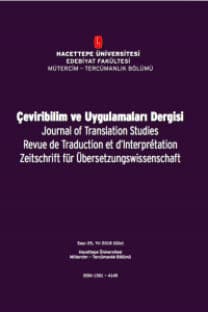İlk Hemşince Kitap Çevirisi: Bidzig Pirens
Dünyada en çok
okunan eserler arasında yer alan Küçük
Prens, Hemşinceye Bidzig Pirens
adıyla çevrilmiştir. Bu çalışmada amaç, ilk olarak, çevirinin önemli bir rolünü
ortaya çıkarmak, kaybolmakta
olan dil ve kültürün sesini duyurarak hayatta kalmalarını sağlamak konusunu
tartışmaya açmaktır. Sonra, çevirmenin tercihleri açısından özellikle sözcükler
düzeyinde, eser üzerinde yapılan incelemelerde görülen yapısal değişiklikler
üzerinde durmaktır. Bu gözlemlenen değişiklikler, Hemşincenin melez yapısını da
ortaya çıkarmaktadır. Yöntem
olarak Gérard Genette’in yan-metinsellik kavramları izlenecek ve betimlemeyle
sınırlı kalınacaktır. Hemşincenin ve Hemşin kültürünün korunması açısından önem
taşıyan söz konusu çeviri eser, yan-metinsel ögeler açısından değerlendirilecek
ve bu bağlamda, eserin ön ve arka kapağı, önsözü, notlar, açıklamalar,
eklemeler, resimler vb. ögeleri incelenecektir. Çevirmenin erek metindeki birtakım
tercihlerinin de Hemşincenin özgün yapısını melezleştirdiği, dolayısıyla dil ve
kültür ögelerinin özgün şekilleriyle gelecek nesillere aktarılmasının
engellendiği söylenebilir mi? Bu arada, Türkçe’nin resmi dil oluşu nedeniyle
Hemşinceyi yıllar içinde nasıl melez bir yapıya dönüştürdüğü de ortaya
çıkmaktadır. Bu durum, ister istemez kültüre yansımakta ve koruma altına
alınmazsa, bir dilin ve kültürün hızla asimile olarak kaybolduğuna şahitlik
etmek durumunda kalınabilecektir. Diğer bir deyişle melez yapı, kaybolmakta olan
bir dil için bir tehlike oluşturmakta mıdır?
Anahtar Kelimeler:
Hemşince, kaybolan dil, kaybolan kültür, melez dil, baskın dil
The Role of the Translator and the Translation Strategies in Bidzig Pirens, the First Book and Translation in Hamshetsma
The Little Prince, one of the most widely
read works in the world, was translated into Homshetsma as Bigzid Pirens. There
are three main objectives in this study. First of all, it is to discuss the role of translation in revealing an important
role, to endure the survival of the vanishing language and culture. In
addition, possible structural changes are observed in the analysis of the work,
especially at the level of words, in terms of translator’s preferences. These
observed changes also reveal the hybrid structure of the Homshetsma. As a method, Gérard Genette’s concepts will be
followed and limited to the description. The translation, which is important
for the protection of Homshetsma and Hemshin culture, will be evaluated in
terms of paratextual elements and in this context, the front and back cover of
the work, preface, notes, explanations, additions, pictures and other elements.
Is it possible to say that some of the preferences of the translator in the
target text do not hybridize to the original structure of the Homshetsma and
thus prevent the transmission of the elements of language and culture with
their original forms to the text generations? In the meantime, because of the
dominance of the Turkish language, the official language and how Homshetsma became
a hybrid structure over the years. If this situation inevitably resolves to
culture and is not protected, it may be necessary to witness the rapid
disappearance of a language and culture. Is the hybrid structure a danger to a
vanishing language?
___
- Aktulum, K. (2000). Metinlerarası İlişkiler. Ankara: Öteki Yayınevi.
- Aras Yayıncılık. (t.y.). Erişim: 10 Haziran 2018. https://www.arasyayincilik.com/tr/hakkimizda
- Berman, A. (1999). La Traduction et la lettre ou l’Auberge du Lointain. Fransa: Edition du Seuil
- Bhabha, H. K. (1994). The Location of Culture. London and New York: Routledge.
- Ersoy, E. G. (2007). Social and Economic Structures of the Hemshin People in Çamlıhemşin. The Hemshin: History, Society and Identity in the Highlands of Northeast Turkey. H. H. Simonian(Ed.). London: Routledge.
- Genette, G. (1991). Introduction to the Paratext. (Çev. M. Maclean. New Literary History, 22 (2), 261-272.
- Munday, J. (2008). Introducing Translation Studies. London and New York: Routledge.
- Saint-Exupéry, A. (2016). Bidzig Pirens (M. Özkan, Çev.) İstanbul: Aras.
- Saint-Exupéry, A. (2015) Küçük Prens.(C. Süreya ve T. Uyar, Çev.) İstanbul: Can Yayınları.
- Simonian, H. H. (2007). The Hemshin: History, Society and Identity in the Highlands of Northeast Turkey. London: Routledge.
- Taş, S. (2018). Yan-metinsel Bulunuş’un Ötesine Geçmek: Çevirmenlerin Erek Metinlerdeki Farklı Rolleri. International Journal of Language Academy. 6 (1), 148-160.
- Vaux, B. (2007). Homshetsma: The Language of the Armenians of Hamshen. The Hemshin: History, Society and Identity in the Highlands of Northeast Turkey. H. H. Simonian(Ed.). London: Routledge.
- Venuti, L. (2008). The Translator’s Invisibility: A History of Translation. London and New York.
- Yayın Aralığı: Yılda 2 Sayı
- Başlangıç: 1991
- Yayıncı: Hacettepe Üniversitesi
